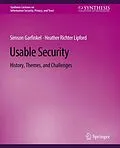There has been roughly 15 years of research into approaches for aligning research in Human Computer Interaction with computer Security, more colloquially known as ``usable security.'' Although usability and security were once thought to be inherently antagonistic, today there is wide consensus that systems that are not usable will inevitably suffer security failures when they are deployed into the real world. Only by simultaneously addressing both usability and security concerns will we be able to build systems that are truly secure. This book presents the historical context of the work to date on usable security and privacy, creates a taxonomy for organizing that work, outlines current research objectives, presents lessons learned, and makes suggestions for future research.
Autorentext
Simson Garfinkel is an Associate Professor at the Naval Postgraduate School. Based in Arlington VA, Garfinkel's research interests include digital forensics, usable security, data fusion, information policy, and terrorism. He holds seven US patents and has published dozens of research articles on security and digital forensics. He is an ACM Fellow and an IEEE Senior Member, as well as a member of the National Association of Science Writers. Garfinkel is the author of 14 books on computing. He is perhaps best known for his book Database Nation: The Death of Privacy in the 21st Century. Garfinkel's most successful book, Practical UNIX and Internet Security (co-authored with Gene Spafford), has sold more than 250,000 copies and been translated into many languages since the first edition in 1991. Garfinkel is also a journalist and has written more than a thousand articles about science, technology, and technology policy. He has won numerous journalism awards, including the Jesse H. Neal National Business Journalism Award for his ""Machine shop"" series in CSO magazine.
